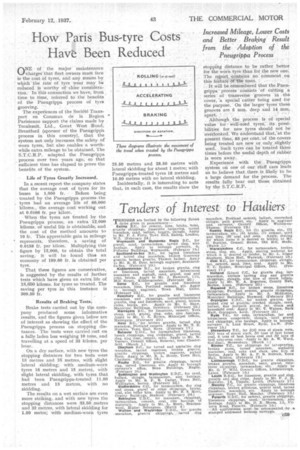How Paris Bus-tyre Costs Have Been Reduced
Page 109

If you've noticed an error in this article please click here to report it so we can fix it.
Increased Mileage, Lower Costs and Better Braking Result from the Adoption of the Pneugrippa Process
ONE of the major maintenance charges that fleet owners must face is the cost of tyres, and any means by which the rate of tyre wear may be reauced is worthy of close consideration. In this connection we have, ftorn time to time, referred to the benefits of the Pneugrippa process of tyre grooving.
The experiences of the Societe Transport en Commun de la Region Parisienne support the claims made by Tecalemit, Ltd., Great West Road, 33rentford (sponsor of the Pneugripp'a process in this country), that the system not only increases the safety of worn tyres, but also enables a worthwhile extra mileage to be obtained. The S.T.C.R.P. adapted the Pneugrippa process over two years ago, so that sufficient time has elapsed to prove the benefits of the system.
Life of Tyres Greatly Increased.
In a recent report the company states that the average cost of tyres for its buses is 1,000 fr. Before being treated by the Pneugrippa process the tyres had an average life of 60,000 Idioms., the average cost working out at 0.0166 Ir. per kilorn.
When the tyres are treated by the Pneugrippa process, an extra 12,000 kiloms. of useful life is obtainable, and the cost of the method amounts to 10 fr. This appreciable gain in mileage
• represents, therefore, a saving of 0.0158 fr. per kilom. Multiplying this figure by 12,000, to obtain the total saving, it will be found Omit an economy of 189.60 fr. is obtained per tyre.
That these figures are conservative, is suggested by the results of further tests which have given an extra life of 18,650 kiloms. for tyres so treated. The saving per tyre in this instance is 309.50 fr.
Results of Braking Tests.
Brake tests carried out by the company produced some informative results, and the figures given below are of interest as showing the effect of the Pneugrippa process on stopping distances. The tests were carried out on a fully laden bus weighing 10 tons, and travelling at a speed of 35 kiloms. per hour.
On a dry surface, with new tyres the stopping distances for two tests were 18 metres and 16 metres, with slight lateral skidding; with medium-worn tyres 16 metres and 15 metres, with slight lateral skidding, with tyres that had been Pneugrippa-treated 11.50 metres and 13 metres, with no skidding.
The results on a wet surface are even more striking, and with new tyres the stopping distances were 33.50 metres and 32 metres, with lateral skidding for 1.50 metre; with medium-worn tyres
stopping distance to be rather better for the worn tyre than for the new one. The report contains no c6inthent ,on
this feature of the tests. "
It will be remembered that the Pneugrippa' process cOnsists of cutting a series .of transverse grooves in _the cover, a special cutter being used for the purpose. On the larger tyres these grooves are 5 mm. deep and 14 ram. apart.
Although the process is of special value for• well-used tyres, its possil. bilities for new tyres should not be overlooked. We understand that;at the present time, 86 per cent. of the covers being treated are new or only slightly used. Such tyres can be treated three times before the useful depth of rubber is worn away.
Experience with the Pneugrippa system on one of our staff cars leads us to believe that there is likely to be a large demand for the process. The results fully bear out those obtained by the S.T.G.R.P.




























































































































































